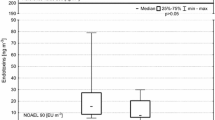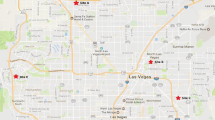Abstract
In this exploratory study, indoor and outdoor airborne fungal spores, pollen, and (1→3)-β-D-glucan levels were determined through long-term sampling (24-h) using a Button Personal Inhalable Aerosol Sampler. The air samples were collected in five Cincinnati area homes that had no visible mold growth. The total count of fungal spores and pollen in the collected samples was conducted under the microscope and Limulus Amebocyte Lysate (LAL) chromogenic assay method was utilized for the determination of the (1→3)-β-D-glucan concentration. For the combined number concentration of fungal spores and pollen, the indoor and outdoor geometric mean values were 573 and 6,435 m−3, respectively, with a geometric mean of the Indoor/Outdoor (I/O) ratio of .09. The geometric means of indoor and outdoor (1→3)-β-D-glucan concentrations were .92 and 6.44 ng m−3, respectively, with a geometric mean of the I/O ratio equal to .14. The I/O ratio of (1→3)-β-D-glucan concentration was found to be marginally greater than that calculated based on the combined number concentration of fungal spores and pollen. This suggests that (1→3)-β-D-glucan data are affected not only by intact spores and pollen grains but also by the airborne fragments of fungi, pollen, and plant material, which are ignored by traditional enumeration methodologies. Since the (1→3)-β-D-glucan level may elucidate the total exposure to fungal spores, pollen, and fungal fragments, its I/O ratio may be used as a risk marker for mold and pollen exposure in indoor environments.
Similar content being viewed by others
References
Adhikari, A., Martuzevicius, D., Reponen, T., Grinshpun, S. A., Cho, S., Sivasubramani, S. K., Zhong, W., Levin, L., Kelly, A. L., St Clair, H., & LeMasters, G. (2003). Performance of the Button Personal Inhalable Sampler for the measurement of outdoor aeroallergens. Atmospheric Environment, 37, 4723–4733.
Adhikari, A., Reponen, T., Grinshpun, S., Martuzevicius, D., & LeMasters, G. (2006). Correlation of ambient inhalable bioaerosols with particulate matter and ozone: A two-year study. Environmental Pollution, 140, 16–28.
Beijer, L., Thorn, J., & Rylander, R. (2006). Effect after inhalation of (1→3)-β-d-glucan and relation to mould exposure in the home. Mediators of Inflammation, 11, 149–153.
Beijer, L., Thorn, J., & Rylander, R. (2003). Mould exposure at home relates to inflammatory markers in blood. European Respiratory Journal, 21, 317–322.
Brasel, T. L., Douglas, D. R., Wilson, S. C., & Straus, D. C. (2005). Detection of airborne Stachybotrys chartarum macrocyclic trichothecene mycotoxins on particulates smaller than conidia. Applied and Environmental Microbiology, 71, 114–122.
Bornehag, C-G., Blomquist, G., Gyntelberg, F., Järvholm, B., Malmberg, P., Nordvall, L., Nielsen, A., Pershagen, G., & Sundell, J. (2001). Dampness in buildings and health. Indoor Air, 11, 72–86.
Burge, H. A., & Rogers, C. A. (2000). Outdoor allergens. Environmental Health Perspectives, 108, 653–659.
Chew, G., Douwes, J., Doekes, G., Higgins, K., Van Strien, R., Spithoven, J., & Brunekreef, B. (2001). Fungal extracellular polysaccharides, β (1→3)-glucans and culturable fungi in repeated sampling of house dust. Indoor Air, 11, 171–178.
Cho, S. H., Seo, S. C., Schmechel, D., Grinshpun, S. A., & Reponen, T. (2005). Aerodynamic characteristics and respiratory deposition of fungal fragments. Atmospheric Environment, 39, 5454–5465.
Douwes, J. (2005). (1→3)-β-d-glucans and respiratory health: A review of the scientific evidence. Indoor Air, 15, 160–169.
Foto, M., Vrijmoed, L. P., Miller, J. D., Ruest, K., Lawton, M., Dales, R. E. (2005). A comparison of airborne ergosterol, glucan and Air-O-Cell data in relation to physical assessments of mold damage and some other parameters. Indoor Air, 15, 257–266.
Fogelmark, B., Thorn, J., & Rylander, R. (2001). Inhalation of (1→3)-beta-d-glucan causes airway eosinophilia. Mediators Inflammation, 10, 13–19.
Górny, R., Reponen, T., Willeke, K., Schmechel, D., Robine, D., Boissier, M., & Grinshpun, S. A. (2002). Fungal fragments as indoor air biocontaminants. Applied and Environmental Microbiology, 68, 3522–3531.
Górny, R., Mainelis, G., Grinshpun, S. A., Willeke, K., Dutkiewicz, J., & Reponen, T. (2003). Release of Streptomyces albus particles from contaminated surfaces. Environmental Research, 91, 45–53.
Grinshpun, S. A., Aizenberg, V., Willeke, K., Smith, J. P., & Baron, P. A. (1998). Personal aerosol sampler with curved porous inlet: wind tunnel evaluation using a full-size manikin. Journal of Aerosol Science, 29 S1137–S1138.
Lee, T., Grinshpun, S. A., Martuzevicius, D., Adhikari, A., Crawford, C. M., Luo, J., & Reponen, T. (2006). Relationship between indoor and outdoor bioaerosols collected with a Button Inhalable Aerosol Sampler in urban homes. Indoor Air, 16, 37–47.
Lierl, M. B., & Hornung, R. W. (2003). Relationship of outdoor air quality to pediatric asthma exacerbations. Annals of Allergy, Asthma, and Immunology, 90, 28–33.
Odabasi, Z., Mattiuzzi, G., Estey, E., Kantarjian, H., Saeki, F., Ridge, R. J., Ketchum, P. A., Finkelman, M. A., Rex, J. H., Ostrosky-Zeichner, L. (2004). Beta-d-glucan as a diagnostic adjunct for invasive fungal infections: Validation, cutoff development, and performance in patients with acute myelogenous leukemia and myelodysplastic syndrome. Clinical Infectious Diseases, 39, 199–205.
Osborne, M., Reponen, T., Adhikari, A., Cho, S. H., Grinshpun, S. A., Levin, L., Bernstein, D. I., & LeMasters, G. (2006). Specific fungal exposures, allergic sensitization, and rhinitis in infants. Pediatric Allergy and Immunology, in press.
Portnoy, J. M., Kwak, K., Dowling, P., VanOsdol, T., & Barnes, C. (2005). Health effect of indoor fungi. Annals of Allergy, Asthma & Immunology, 94, 313–320.
Ruizherrera, J. (1991). Biosynthesis of beta-glucan in fungi. Antonie Van Leeuwenhoek. International Journal of General and Molecular Microbiology, 60, 73–81.
Rylander, R. (1997a). Investigations of the relationship between disease and airborne (1→3)-β-d-glucan in buildings. Mediators of Inflammation, 6, 275–277.
Rylander, R. (1997b). Airborne (1→3)-β-d-glucan and airway disease in a day-care center for before and after renovation. Archives of Environmental Health, 52, 281–285.
Rylander, R. (1999). Indoor air-related effects and airborne (1→3)-β-d-glucan. Environmental Health Perspectives, 107(Suppl 3), 501–503.
Rylander, R., Fogelmark, B., McWilliam, A., & Currie, A. (1999). (1→3)-β-d-glucan may contribute to pollen sensitivity. Clinical and Experimental Immunology, 115, 383–384.
Rylander, R., Norrhall, M., Engdahl, U., Tunsater, A., & Holt, P. G. T. (1998). Airways inflammation, atopy, and (1→3)-β-d-Glucan exposures in two schools. American Journal of Respiratory and Critical Care Medicine, 158, 1685–1687.
Schram-Bijkerk, D., Doekes, G., Douwes, J., Boeve, M., Riedler, J., Üblagger, E., Mutius, E., Benz, MR., Pershagen, G., Hage, M., Scheynius, A., Braun-Fahrländer, C., Waser, M., & Brunekreef, B., (2005). Bacterial and fungal agents in house dust and wheeze in children: the PARSIFAL study. Clinical and Experimental Allergy, 35(10), 1272–1278.
Smith, E. G. (1990). Sampling and identifying allergenic pollens and molds. San Antonio, TX: Blewstone Press.
Taylor, P. E., Flagan, R. C., Valenta, R., & Glovsky, M. M. (2002). Release of allergens as respirable aerosols: A link between grass pollen and asthma. Journal of Allergy Clinical Immunology, 109, 51–56.
Taylor, P. E., Flagan, R. C., Miguel, A. G., Valenta, R., & Glovsky, M. M. (2004). Birch pollen rupture and the release of aerosols of respirable allergens. Clinical and Experimental Allergy, 34, 1591–1596.
Thorn, J., & Rylander, R. (1998). Airways inflammation and glucan in a rowhouse area. American Journal of Respiratory and Critical Care Medicine, 157, 1798–1803.
Toivola, M., Nevalainen, A., & Alm, S. (2004). Personal exposures to particles and microbes in relation to microenvironmental concentrations. Indoor Air, 14, 351–359.
Wan, G. H., & Li, C. S. (1999). Indoor endotoxin and glucan in association with airway inflammation and systemic symptoms. Archives of Environmental Health, 54, 172–179.
Wang, Z., Reponen, T., Grinshpun, S. A., Górny, R. L., Willeke, K. (2001). Effect of sampling time and air humidity on the bioefficiency of filter samplers for bioaerosol collection. Journal of Aerosol Science, 32, 661–674.
Williams, D. L. (1997). Overview of (1→3)-β-d-Glucan immunobiology. Mediators of Inflammation, 6, 247–250.
Acknowledgements
This research study was partially supported by the National Institute for Occupational Safety and Health (NIOSH) Pilot Research Project Training Program of the University of Cincinnati Education and Research Center Grant #T42/OH008432-01. This support is greatly appreciated. The investigators are also grateful to Dr. Detlef Schmechel of NIOSH for helpful discussions and to the residents of the studied homes for their cooperation.
Author information
Authors and Affiliations
Corresponding author
Rights and permissions
About this article
Cite this article
Lee, T., Grinshpun, S.A., Kim, K.Y. et al. Relationship between indoor and outdoor airborne fungal spores, pollen, and (1→3)-β-D-glucan in homes without visible mold growth. Aerobiologia 22, 227–235 (2006). https://doi.org/10.1007/s10453-006-9034-y
Received:
Accepted:
Published:
Issue Date:
DOI: https://doi.org/10.1007/s10453-006-9034-y




